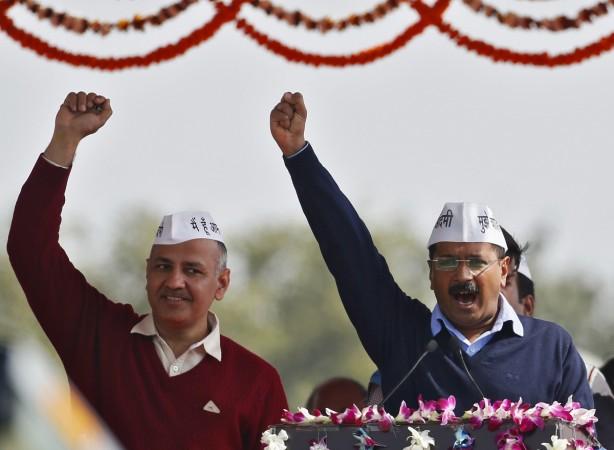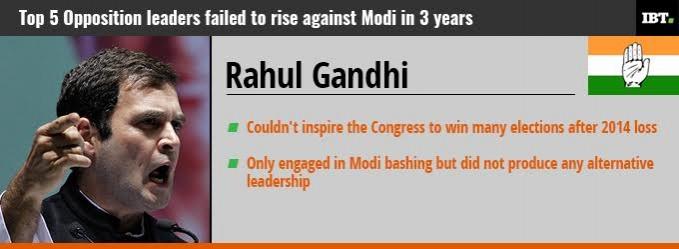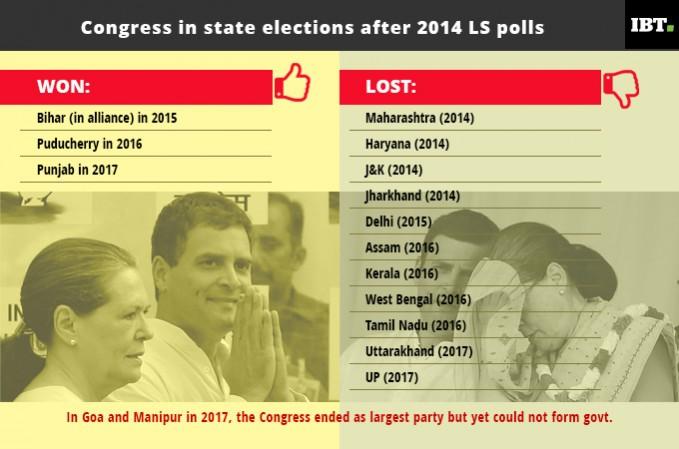
Prime Minister Modi has continued to rule the hearts of the majority and his tag can be easily changed from 'Hindu Hriday Samrat' to 'Bharat Samrat'. The leader is so popular even after three years that according to many, the Lok Sabha election of 2019 will only be an anti-climax.
This brings us to the other side of the story. If Modi has had a near-perfect record in the last three years, how the Opposition has done during the same time?
Also read: The hits & misses of Modi govt in three years
After the Opposition dominated India's political scene since the fall of the Rajiv Gandhi in 1989 and the onset of the coalition era, the outcome of the 2014 Lok Sabha election was quite a phenomenon.
Even Modi said soon after the results came out that it is now time for the Opposition and not the government to stitch a coalition for survival. Modi was spot on and even after three years, the anti-Modi forces have only struggled to get their act together.
If we pick each of the prominent leaders in the Opposition rank to understand how they have performed, the only adjective we will have to describe our feeling is disappointment.
Rahul Gandhi: A no show
Take for example, the case of Congress vice-president Rahul Gandhi. Though his party was reduced to its lowest-ever stature in Parliament with just 44 seats in 2014, yet it was the second-largest after the BJP and whether the Grand-Old Party technically was not fit to become the main Opposition party, Rahul always had a responsibility to fulfil but he failed utterly.

We have only seen the leader resorting to anti-Modi rhetoric in the last three years instead of building a viable alternative.
The Congress's compulsive opposition to issues like Goods and Services Tax or creating ruckus in Parliament have not yielded any result. Rahul Gandhi, who has no experience in administrative affairs, also failed to inspire his party in the electoral battles in various states, losing almost all of them.

The only two places where the Congress could form government on its own in these three years are Puducherry and Punjab while it lost power in several. The Congress's only gain in the Lok Sabha in these years was winning a by-election in MP to take its paltry tally to 45.
Mamata Banerjee: More noise than substance
Mamata Banerjee of the Trinamool Congress (TMC), the ruling party of West Bengal, was more visible as the Opposition leader than Rahul Gandhi though she could not convince many with her politics.
Banerjee opposed and criticised the Modi government for almost everything but being a regional leader, she could not go beyond a point. Her party finished as the fourth-largest party in the last general elections with 34 seats but since it was a decisive mandate for the BJP-led NDA, Banerjee did not have much to do but shout from the sidelines.
Still, she tried to flex her muscles by vetoing the Teesta water-sharing deal between India and Bangladesh and blowing hot and cold on the GST but it will be interesting to see how much she succeeds.

Banerjee also tried her best to cash in on issues like demonetisation and build a federal front against Modi but the latter's massive success in the Uttar Pradesh elections earlier this year dashed her hopes.
The highest point for Banerjee after Modi came to power was her victory in the Bengal Assembly polls in 2016. On the other hand, the endless number of corruption charges against leaders of her own party has hurt the TMC supremo's image of honesty.
Arvind Kejriwal: Too high ambitions did him in
The third Opposition leader who made the headlines quite frequently but could not really achieve much in the end is Arvind Kejriwal of the Aam Aadmi Party (AAP). The Delhi chief minister did not see a decent maiden general election as his party could muster just four seats despite contesting in over 400 seats.
But Kejriwal succeeded in puncturing Modi's balloon in the 2015 Delhi Assembly election in which his party won 67 out of 70 seats. Thereafter started the revolutionary leader's slide. Controversies over appointing parliamentary secretaries, confrontations with the lieutenant governors of Delhi, rifts in the party, mindless greed for publicity and even embracing a convicted politician like Lalu Prasad without caring for his own image of an anti-corruption crusader undid the phenomenon called Kejriwal.

The AAP leader was never seen getting his four parliamentarians involved in institutional opposition against the NDA but only cared to give bytes to the media targeting Modi. It did not harm Modi for the BJP leader never misused his own popularity and allowed his impatient opponents to make mistakes.
Kejriwal had shown a lot of potential for he arrived at the political scene like a fresh air, similar to Modi, but unlike the latter, committed much too errors to dig his own grave. After losing in the state elections in Punjab and Goa as well as in the civic polls in Delhi and with a serious crack now emerging in the party following the serious corruption charges brought by Kapil Mishra against him, it looks Kejriwal's career graph is going anywhere but up.
Nitish Kumar: The only leader to have shown maturity
The other leader who still matters as an Opposition leader in Modi-fied India is JD(U) leader Nitish Kumar. The Bihar chief minister had a strong reservation over Modi's rise in the NDA's ranks before the general elections of 2014 and pulled out of the alliance questioning Modi's secular credentials. But Kumar soon found the harsh reality as his party was humiliated in its own den by the Modi wave.
Kumar, who was seen as a close competitor of Modi as the chief minister, quit the CM's post and installed a stooge who, however, grew his own wings to challenge him. It took much of an effort for Kumar to return as the chief minister of Bihar after defeating the BJP in the state polls jointly with old foe Lalu Prasad. But unlike Banerjee and Kejriwal, Kumar never went after Modi for he is clever enough to understand that opposing the latter for the sake of it will only backfire.

Kumar did not oppose Modi's demonetisation moves or his government's 'surgical strikes' against Pakistan because he knows Modi is the man of the moment.
Kumar has also humbly conceded that he is not in the race to become PM in 2019 which speaks volumes about his maturity. As a non-BJP leader, Kumar will be worried over his minority vote-bank and the future of his vulnerable joint government with Lalu Prasad but he has taken a step back to wait for his time. By limiting his national ambitions, Kumar might not have played the role of an Opposition to Modi, but at the same time, he has been exposed less than the Rahul-Banerjee-Kejriwal trio.
Mulayam Singh: A man of the past
Had it been five years ago, Samajwadi Party's (SP) Mulayam Singh Yadav would also have been counted among potent Opposition leaders. But the SP's internal tussle and the pathetic loss in the general elections of 2014 as well as the UP elections this year have pushed the veteran leader to the brink.

An ageing Mulayam has not only lost his clout at the Centre in the age of single-party majority but also failed to reproduce the 2012 magic in his home state. For a man who had played a major role in India's coalition politics over the years, the last 36 months have been forgettable.
Mayawati: Facing survival crisis
Mulayam's arch-rival and Bahujan Samaj Party (BSP) Mayawati is another prominent regional face and could play a strong role in the anti-Modi front and recover her Dalit vote bank. But the BSP's drawing blank in the last general elections and also the poor show in the recent UP elections have raised serious questions over the Dalit messiah's political past as well as future.
Jayalalithaa is dead
Another major leader who has been known for playing a significant role in the national politics though from her own state is Jayalalithaa. However, though her AIADMK ended as the third biggest party in the Lok Sabha elections of 2014 with 37 seats, corruption charges, ailing health and the BJP's dominance at the Centre did not give her much chance to pull the strings. Eventually, Jayalalithaa, who had a good relation with PM Modi, passed away in December 2016, creating a vacuum in her state's politics.
Left has faded fast
The Left deserves a mention because ideologically, it stands at the opposite end of the spectrum. But the Left's gradual decline even in states where they have been powerful in the Modi era speaks much about their losing currency in Indian political thought. The BJP is gradually increasing its power in West Bengal, Kerala and even in Tripura, the only three states where the Left matters, proving that it has failed to reinvent itself and fast losing ground to the saffron camp.
Thanks to the BJP's strong presence in both Houses of the Centre [after the UP victory, its presence in the Rajya Sabha is certain to go up], a number of regional satraps who called the shots at the Centre even at the expense of the government's survival, have now been pushed to the corner. In fact, they are even finding it difficult to defend their own fortresses [Mulayam, Mayawati and Kejriwal have already tasted it] and this has put their future under a spot.
In the last three years, India's Opposition has only vowed to topple Modi, sometimes even in disunity. In reality, they haven't succeeded much.

















